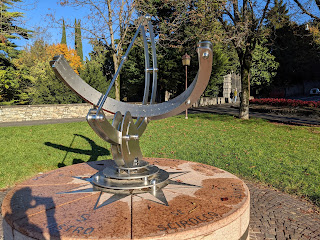


Left and center: Example RAI weather forecasts showing named wind directions, on September 28 and 30, 2020.
Right: A sundial in Bergamo Città Alta.
This sundial (meridiana in Italian) is an equatorial bow sundial that shows the time and the compass rose. You can find it on the Baluardo di San Giovanni, one of the bastions of the Venetian Walls of Bergamo. Not only being a pretty example of a sundial, it also is interesting because it provides the common names of the direction of winds, which are used often in Italy when discussing the weather.
In the US, wind is usually discussed in terms of direction from which it originates, using the compass rose. For example, winds from the north are northerly winds. There are exceptions and named winds exist like the Santa Ana winds and the Witch of November. For more examples, see the Wikipedia entry List of Local Winds. If you don’t live in an area where a particular named wind is used, you probably wouldn’t know about it. In other words, the named winds (other than based on direction) are not commonly used across the USA.
- N – north – tramontana
- NE – northeast – grecale
- E – east – levante
- SE – southeast – scirocco
- S – south – ostro
- SW – southwest – libeccio
- W – west – ponente
- NW – northwest – maestrale
There are regional-specific names for the eight names above as well as other regional weather phenomenon names, usually depending on local geography.
The English Wikipedia entry on the compass rose states that the eight names come from the Mariner’s compass rose used by seafarers in the Mediterranean during medieval times, maybe as far back as the 11th and 12th centuries. The names come from a pidgin language called Sabir. While the exact origins are not clear, two (Ostro and Libeccio) have classical etymologies and two (Scirocco and Garbino, another name for SW winds) have Arab etymologies. So, we have ancient seafarers to thank for these names.
The Italian Wikipedia entry on the compass rose adds that to understand the NE, SE, SW, and NW wind names you need to put yourself somewhere in the Ionian Sea. The Greek island of Zakynthos is given as one example. Then the directions for the northeast, southeast, southwest and northwest start to make sense. Northeast of our hypothetical point in the Ionian Sea is Greece (hence, Grecale). Southeast is Syria (Scirocco derives from al-Sharq, east in Arabic). Southwest is Libya (Libeccio is comes from the Greek libykós, meaning "of Libya", or from the Arabic lebeǵ, which derives from the Greek líps-libós, which means "wind that brings rain). Northwest is the direction toward Rome or Venice depending on where exactly your hypothetical is in the Ionian Sea (Maestrale from maestro).
The sundial in Bergamo tells:
- T.M.E.C. is Central European Mean Team. (Literally tempo medio dell'Europa Centale.) Italy goes to this time (one hour back) between the last Sunday in October and the last Sunday in March.
- Solare We are not sure how to use this part. It seems like it helps you know what season you are in and whether to use the T.M.E.C. or Legale hours. But we think it must be read at noon to be sure. In our photos below we have three readings:
- September 16, 2020 at 9:20 am. Time read off of Legale band.
- October 13, 2020 at 9:18 am. Time read off of Legale band.
- February 16, 2021 at 9:17 am. Time read off of TMEC band.
- November 2, 2021 at 9:16 am. Time read off of TMEC band.
- Legale is daylight savings time or summertime when clocks are advanced one hour ahead typically from the end of March to the end of October.
On this sundial, there doesn’t appear to be a EOT (equation of time) correction.
The sundial is made by OrologioSolare by Mauro Fizzanotti, and was installed in 2003.


Left: An equatorial bow sundial in Bergamo Città Alta.
Center and Right: Named wind directions at the base of the sundial.


Left: The sundial set to the latitude of Bergamo at 45°41'56"04 N.
Right: The sundial pointing view north at 9:20 am October 13, 2020. Use Legale band.


Left: Gnomon shadow at 9:20 am on September 16, 2020 is just below Solare band. Time read from Legale band.
Right: Gnomon shadow at 9:18 am on October 13, 2020 is above the TMEC band. Time read from Legale band.

The sundial on February 16, 2021 at 9:17am. Time read from TMEC band.







No comments:
Post a Comment
All comments are moderated. If your comment doesn't appear right away, it was likely accepted. Check back in a day if you asked a question.